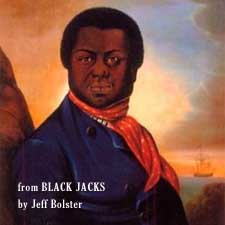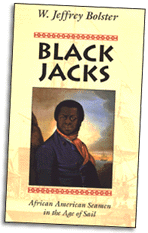|
FRESH STUFF DAILY |
|
|
||
|
|
||
|
|
||
|
SEE ALL SIGNED BOOKS by J. Dennis Robinson click here |
||
Page 1 of 7
Ten years in preparation, Prof. Jeffrey Bolster's detailed book on black mariners is a landmark publication. This interview was recorded at SeacoastNH.com offices by J. Dennis Robinson, two months prior to the book's release.
An Interview With author W. Jeffrey Bolster BLACK JACKS SeacoastNH.com: During the age of sail what was the role of black mariners. It's a role we've never even heard of before. SeacoastNH.com: You tell us in your book that as many as twenty-five percent of mariners on these ships were black. How did they disappear from history if they were so important? Another reason is that in the early 20th century a lot of the maritime history museums that were created were children really of the colonial revival. They were created by well-to-do, white easterners, wishing to capture a certain vision of their past and there was an airbrushing out of black people in a variety of roles, specifically in the maritime roles. In the kind of iconography -- the placemats, the posters, the film casting, the statuary that was meant to evoke the maritime past became transformed. No longer did you see, like in the federal crew list, 20 or 25 percent black men in a given ship. You didn't see any. So for various reasons within the white communities, within the black communities in seaports up and down the east coast, the memory of what was once a very important part of African American, what was once a very important part of maritime America, was lost. SeacoastNH.com: If you had to do a case history or try to come up with a portrait of the black mariner at this time -- what was he like? Bolster: In the late 1700s, in the age of the American Revolution, the black mariner would be a man, probably in his 20s or early 30s. much more likely than his white shipmates to have a family because white sailors were notoriously single, footloose and fancy free in some ways. Black men found so few opportunities to make a living that they were more likely to stick with this very difficult employment -- seafaring -- while still trying to raise a family. Sort of a catch-22 situation. The man in the late 1700s was very likely to have been born a slave. It was almost certain that his parents had been slaves because there were so few free black people in these colonies before the revolution. That man, however, might have come from the Chesapeake Bay region -- Virginia, Maryland -- he might well have come from the Carolinas. He might well have come from the Caribbean Islands or from a north seaport like Boston or Providence, R.I. In other words, in almost every colony of the British empire, all of which were maritime colonies, men of color sailed aboard these ships and as they shifted from being slaves to free men they continued to work at sea. QUICK CLICK to Questions What happened when free mariners encountered a world of slavery? How did these sailors disseminate black culture? What about black mariners in Seacoast NH? Tell us about the 10 years you spent as a mariner and the 10 years you spent writing this book. What do you hope the impact of this book will be? About the Author
Please visit these SeacoastNH.com ad partners.
News about Portsmouth from Fosters.com |
| Wednesday, April 17, 2024 |


|
Copyright ® 1996-2020 SeacoastNH.com. All rights reserved. Privacy Statement
Site maintained by ad-cetera graphics

 Stories
Stories





















